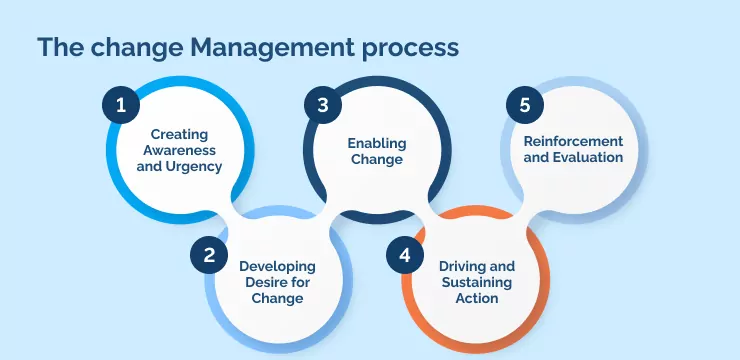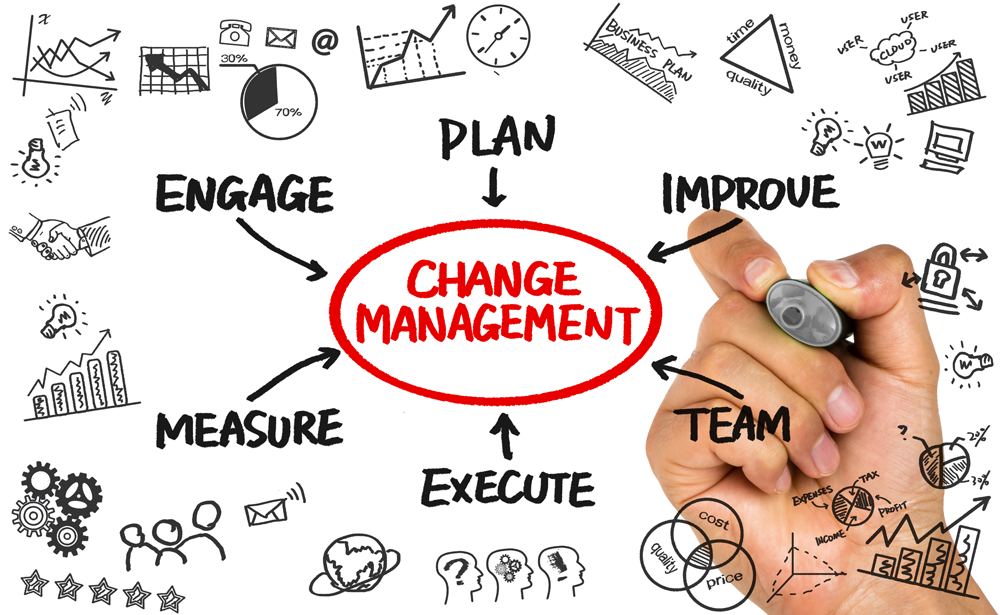Mastering Change Management
for Lasting Success
- Af Zenia Henckel
- September 12, 2024

Effectively Navigating Organizational Transformation
Change management helps teams and organizations make a transformation of the goals, processes, and technologies relevant to the organizational project or environment. By using this systematic approach, teams are able to effectively implement strategies that affect and control the change desired. Thereby, helping people adapting to the change.
In change management, it is crucial to prioritize the people within the organization. Many employees may not be fully prepared or equipped to adjust their methods of working and collaboration, which is why they require effective guidance to successfully adapt to evolving management strategies.
Change is a constant—whether in technology, leadership, management, or human behavior. Therefore, it is essential to guide individuals in the right direction, helping them adapt to new conditions, embrace technological advancements, and optimize processes.
Change management must be integrated in these situations to ensure a smooth transition that engages all stakeholders. It involves managing every aspect of change in IT services—planning, testing, implementation, and evaluation—to minimize the risk of disruptions and errors. This approach fosters a controlled and coordinated environment that maximizes opportunities for advancement.
The Steps of Succesful Change Management

The stages of change management provide a comprehensive framework for identifying key areas of focus when creating or adapting to change within a team or organization. This approach ensures that all aspects of change management are addressed, increasing the likelihood of successful transformations and sustainable outcomes.
The five steps outlined in the following article define the process of implementing change management in a structured, step-by-step manner.
- Creating Awareness & Urgency
The first step involves raising awareness and building an understanding of the necessary changes within the team or organization, while preparing members and stakeholders for what lies ahead. It is the change manager’s responsibility to address concerns and resistance by maintaining open communication and ensuring that staff have an opportunity to voice their perspectives on the situation. - Developing Desire for Change
At this stage, we develop the strategy for the desired transformation once stakeholder approval for the change is secured. The change management team creates a plan to address potential challenges and ensures that everyone understands their role in the management process from start to finish. - Enabling Change
After finalizing the change management plan, we proceed with implementation. It is essential that everyone fulfills their responsibilities, ensuring employee satisfaction, which in turn supports the process and helps maintain a smooth and productive working environment. - Driving & Sustaining Action
Now that the changes have been implemented, it is crucial to sustain the transformation to prevent staff from reverting to old routines. Once the new system is fully operational, we can provide staff training and clarify the updated structures to ensure lasting success. - Reinforcement & Evaluation
Now that the changes have been implemented and the staff understands their roles and responsibilities, we can evaluate the outcomes of the change management process and determine how to sustain the transformation. The change manager reviews the strengths and weaknesses of the process and makes adjustments as needed to ensure continuous improvement.
Examples of Change Management

Sustineri has applied change management on numerous occasions, whether when engaging new clients, adopting new technological systems, or relocating. Some clear examples of change management within our organization are outlined in the following text.
- Office Location
We initially operated remotely, working from home or other locations, before moving into our dedicated office space near Kolding train station in April 2024, where we have been based since. Our Communication Expert works full-time from this office, while we maintain communication through various online platforms. - Client Agreements
We began as a small organization, gradually building connections with clients and organizations interested in our services. Over the years, we have expanded our network across Europe and are now aiming to engage with other international organizations. - Technology & Network
We communicate across multiple platforms and will continue to do so. The materials we develop support our communication efforts and enable us to educate clients on their specific service needs. We also utilize various IT tools and platforms to create a wide range of resources, including training materials, websites, and handbooks. - Next Step
Sustineri is an organization dedicated to growth and network expansion. Our goal is to become a larger company with a team of consultants and employees committed to delivering leadership and management services to our future clients.

The 7 R's of Change Management
There are many ways teams and organizations can work with change management and sometimes the easiest way to begin is by asking the right questions. The 7 R’s of Change Management provide a structured framework for evaluating and implementing change in an organization. These seven key questions help ensure that any change is thoroughly considered, minimizing risks and maximizing success.
- Who RAISED the change?
- What is the REASON for the change?
- What is the RETURN required for the change?
- What are the RISKS involved in the change?
- What RESOURCES are required to deliver the change?
- Who is RESPONSIBLE for the build, test and implementation of the change?
- What is the RELATIONSHIP between this change and other change?
These 7 R’s provide a comprehensive approach to managing change, ensuring that every aspect is thoroughly planned and executed to enhance the success of the transition. Once you are able to answer these questions, you will be able to define the change management of your team or organization and what impact it has on the staff.

Konklusion
In conclusion, change management helps organizations navigate transformations, either due to technological advancements, market shifts, or internal restructuring. Change management involves implementing strategies, planning, and sustaining changes while addressing human, operational, and strategic elements involved.
Effective change management not only minimizes disruptions but also ensures that changes are fully integrated into the organization, fostering long-term success and adaptability.
By focusing on clear communication, stakeholder engagement, and continuous evaluation, organizations can effectively manage change, driving growth and innovation in an increasingly dynamic environment as it is important to involve the whole staff to make the desired change.
Referencer
Alexander. (2024, June 19). Naviger med effektiv Change Management. Clever Choice
Hanna, K. T., Lawton, G., & Pratt, M. K. (2024, April 11). change management. CIO
Simplilearn. (2024, April 15). What is Change Management : 7 R’s of Change Management. Simplilearn.com
Staff, C. (2024, July 16). The Change Management Process: What Is It and Who Is It For? Coursera
Åbningstider:
Monday – Thursday 8:00 – 16:00
Friday 8:00 – 15:00
Telefon: +45 8198 5959
E-mail: br@sustineri.dk
Adresse:
Jernbanegade 27,
6000 Kolding,
Danmark
